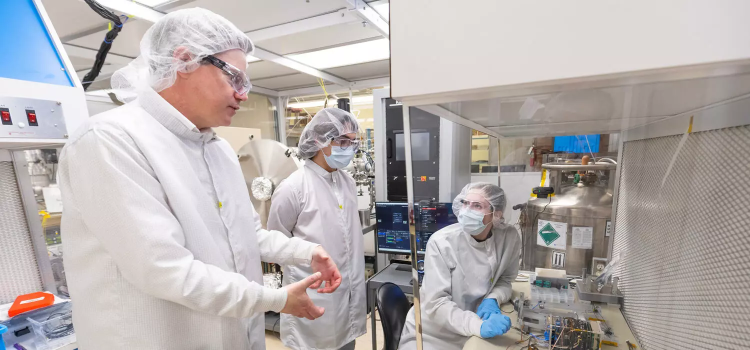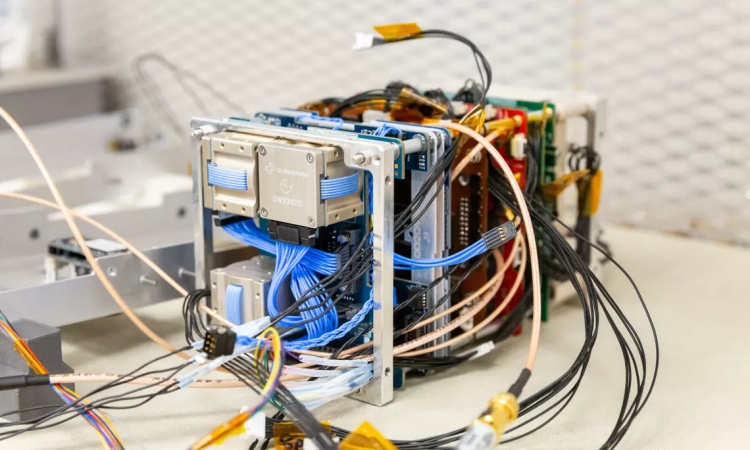A team of University of Calgary students is preparing to launch the first student-built satellite in the history of the city.
The CalgaryToSpace team was created in 2020 with the purpose of giving undergraduate students experience in the space sector, which can often be seen as an intimidating field. Since then, team members have been working to build FrontierSat, a tiny satellite (known as a CubeSat) about the same size as a loaf of bread.

From left: Johnathan Burchill, Victor Borges and Meagan Davies look forward to the launch of the FrontierSat satellite into space in the fall. Photo Credit: Riley Brandt, University of Calgary
"As we've gone along, the satellite has gotten more and more refined through consistent design reviews and stages to get where we are now," says team member Meagan Davies, who is studying in a dual degree in astrophysics and biomedical engineering, under the Faculty of Science and Schulich School of Engineering.
FrontierSat to carry scientific instrument
The satellite has picked up a practical purpose in recent months. Originally, CalgaryToSpace was going to build and launch FrontierSat with internal payloads designed completely by the students. However, Dr. Johnathan Burchill, PhD, an assistant professor in transdisciplinary space science and aerospace technology with the Department of Physics and Astronomy in the Faculty of Science, had a different idea.
"They agreed to fly a particular scientific instrument I had sitting on a shelf waiting for a mission of opportunity," says Burchill, whose mini-plasma imager will sit on the front of FrontierSat and investigate upper atmospheric ionized winds.
Vibration test is final hurdle
The final version of the satellite is being constructed over the next few weeks, and it will then undergo a critical vibration test this month.

The FrontierSat satellite being constructed by students in CalgaryToSpace. Photo Credit: Riley Brandt, University of Calgary
"Vibration testing is shaking your satellite very precisely to simulate launch conditions to make sure it can survive launch," explains Aarti Chandiramani, another member of the CalgaryToSpace team.
"You need to successfully pass a vibration test to qualify for launch," adds Chandiramani, a geomatics engineering and aerospace student whose studies fall under the Faculty of Science and Schulich School of Engineering.
After a successful test, the team can look forward to a launch in the fall. Exolaunch, a Germany company specializing in mission management and launch services, will partner with CalgaryToSpace to ensure the satellite deployment is timed appropriately for the target orbit of 510 kilometres above Earth's surface. The FrontierSat journey to orbit will begin on a SpaceX craft.
"We could definitely fly down and watch it from a field outside, but there's also the aspect of wanting to be close to our control centre at the Rothney Astrophysical Observatory so if we get a response from our satellite, we can work on that right away," says Chandiramani.
No guarantees and mitigating failure
There is no guarantee of success. CubeSats have many different types of failure, including not being able to communicate with ground control, and the chance that the rocket could fail to safely transport the satellite to space at all.
"It's a bit of a risky thing, but that makes it a nice challenge," says Burchill. "If it doesn't work, we'll build satellite two and try again."
The CalgaryToSpace team is in contact with other CubeSat teams across Canada to see how their first launches went and learn how they might avoid failure on their next attempt.
Despite the risk of failure, CalgaryToSpace is optimistic about the satellite and excited about the potential to reach space.
"A lot of us have worked on this for a long time and put in a lot of hours," says Chandiramani. "It's becoming more and more real, now that the cables we're making and the circuit boards that we're soldering are going to be in space, which is pretty astounding."












